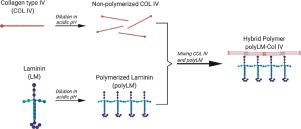Acta Biomaterialia ( IF 9.4 ) Pub Date : 2020-05-22 , DOI: 10.1016/j.actbio.2020.05.021 Tatiana Coelho-Sampaio 1 , Boris Tenchov 2 , Marcos A Nascimento 1 , Camila Hochman-Mendez 3 , Verônica Morandi 4 , Michelle Botelho Caarls 1 , George Altankov 5

|
Tissue engineering demands the development of scaffolds that mimic natural extracellular matrices (ECM). Despite the success in obtaining synthetic interstitial ECM, the production of an artificial basement membrane (BM), the specialized thin sheet of ECM that is pivotal for the functional organization of most tissues and internal organs, is still not achieved. With the long-term aim of developing a flat BM-like structure here we investigated the behavior of acid-soluble Col IV during simultaneous assembly with laminin (LM) in acidic conditions. The underlying rationale was the previously observed phenomenon of acid-triggered LM polymerization, giving rise to biomimetic polylaminin (polyLM) that can be adsorbed on the substrate. Unexpectedly, we found that Col IV (that does not polymerize in acidic conditions) readily incorporated into the polyLM layer, forming a network that mimics to a great extent the characteristic polygonal morphology of single polyLM observable at micrometric scale. Scanning calorimetry and light scattering measurements supported the notion that polyLM and Col IV could directly interact. The biological properties of the proposed artificial BM-like structure were characterized using human keratinocytes (HACAT) and umbilical vein endothelial cells (HUVEC). HACAT formed stratified cell layers on the hybrid polyLM/Col IV layer, but not on Matrigel, nor on LM or Col IV alone, while HUVEC improved cortical F-actin and tight juctions organization on polyLM/Col IV. Thus, the proposed artificial BM reproduces not only morphological but also some functional properties of the natural BM.
Statement of Significance
Basement membranes (BMs) are flat biological matrices separating tissue compartments in the body. Their peculiar sheet-like structure is thought to result from the association of two independent protein networks of laminin and collagen IV. While pursuing the development of an artificial BM, we found that, when mixed with acid-induced polymerized laminin, collagen IV immediately conformed to the laminin shape. This implies that the protein networks may not be independently assembled as believed so far, but instead that laminin may command the assembly of collagen IV. Our hybrid matrix was structurally more stable than the commercial BM extract Matrigel and, unlike the latter, supported in vitro formation of a stratified layer of keratinocytes that approximated the organization of the natural epidermis.
中文翻译:

IV型胶原蛋白符合吸附在平面基底层上的多层粘蛋白的组织。
组织工程需要模拟自然细胞外基质(ECM)的支架的开发。尽管成功地获得了合成的间质性ECM,但仍没有实现人工基底膜(BM)的生产,该基底膜是ECM的专用薄片,对大多数组织和内部器官的功能组织至关重要。为了在此处开发出扁平的类BM结构的长期目标,我们研究了在酸性条件下与层粘连蛋白(LM)同时组装期间酸溶性Col IV的行为。根本原因是先前观察到的酸触发的LM聚合现象,产生了可吸附在基质上的仿生聚丙烯酰胺(polyLM)。不料,我们发现,Col IV(在酸性条件下不会聚合)很容易并入polyLM层,形成了一个网络,该网络在很大程度上模拟了可从微米尺度观察到的单个polyLM的特征多边形形态。扫描量热法和光散射测量法支持polyLM和Col IV可以直接相互作用的观点。使用人类角质形成细胞(HACAT)和脐静脉内皮细胞(HUVEC)来表征拟议的类似BM的人工结构的生物学特性。HACAT在polyLM / Col IV杂化层上形成分层的细胞层,但在Matrigel上或单独在LM或Col IV上均未形成分层细胞,而HUVEC改善了皮质F-肌动蛋白和polyLM / Col IV上的紧密连接组织。从而,
重要声明
基底膜(BMs)是扁平的生物基质,可分隔体内的组织隔室。据认为,它们特殊的薄片状结构是由层粘连蛋白和胶原蛋白IV的两个独立的蛋白质网络结合而成的。在开发人造BM的同时,我们发现,当与酸诱导的聚合层粘连蛋白混合时,胶原蛋白IV立即符合层粘连蛋白的形状。这意味着到目前为止,蛋白质网络可能尚未独立组装,而是层粘连蛋白可能命令胶原IV组装。我们的混合基质在结构上比商业BM提取物Matrigel更稳定,并且与后者不同,它支持体外形成角化细胞分层层,该层近似于天然表皮的组织。











































 京公网安备 11010802027423号
京公网安备 11010802027423号